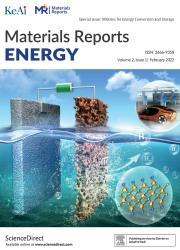高性能富镍阴极的电解质工程与界面化学:进展与展望
IF 13.8
引用次数: 0
摘要
富镍层状氧化物因其高容量、高工作电压和具有竞争力的成本而成为锂电池正极材料。然而,富镍阴极的结构退化和与电解质的界面副反应导致其过早失效,特别是在高电荷截止电压(≥4.4 V)下。为此,研究人员开发了各种结构和界面调节策略(如涂层改性、元素掺杂和电解质工程)来提高富镍阴极的循环生存性。其中,通过改变溶剂化结构和引入添加剂的电解质工程被认为是构建坚固的阴极-电解质界面(CEI)、抑制有害物质(如HF和H2O)的形成或抑制过渡金属离子溶解的有效方法。然而,对于富镍层状阴极的竞争性电解质体系的选择和设计,仍然缺乏系统的指导方针。本文从富镍层状阴极的工作机理出发,综述了近年来富镍层状阴极电解液工程的研究进展。此外,我们提出了改善电解质性能的未来前景,这将为设计高性能富镍层状阴极的新型电解质提供新的见解。本文章由计算机程序翻译,如有差异,请以英文原文为准。

Electrolyte engineering and interphase chemistry toward high-performance nickel-rich cathodes: Progress and perspectives
Nickel (Ni)-rich layered oxides have drawn great attention as cathode for lithium batteries due to their high capacity, high working voltage and competitive cost. Unfortunately, the operation of Ni-rich cathodes suffers from the notorious structural degradation and interfacial side reactions with electrolytes and thus incurs premature failure, especially at high charge cut-off voltages (≥4.4 V). For this, various structural and interphase regulation strategies (such as coating modification, element doping, and electrolyte engineering) are developed to enhance the cycling survivability of Ni-rich cathodes. Among them, electrolyte engineering by changing solvation structure and introducing additives has been considered an efficient method for constructing robust cathode-electrolyte interphases (CEI), inhibiting the formation of harmful species (such as HF and H2O) or restraining the dissolution of transition metal ions. However, there is still an absence of systematic guidelines for selecting and designing competitive electrolyte systems for Ni-rich layered cathodes. In this review, we comprehensively summarize the recent research progress on electrolyte engineering for Ni-rich layered cathodes according to their working mechanisms. Moreover, we propose future perspectives of improving the electrolyte performance, which will provide new insights for designing novel electrolytes toward high-performance Ni-rich layered cathodes.
求助全文
通过发布文献求助,成功后即可免费获取论文全文。
去求助
来源期刊

材料导报:能源(英文)
Renewable Energy, Sustainability and the Environment, Nanotechnology
CiteScore
13.00
自引率
0.00%
发文量
0
审稿时长
50 days
 求助内容:
求助内容: 应助结果提醒方式:
应助结果提醒方式:


